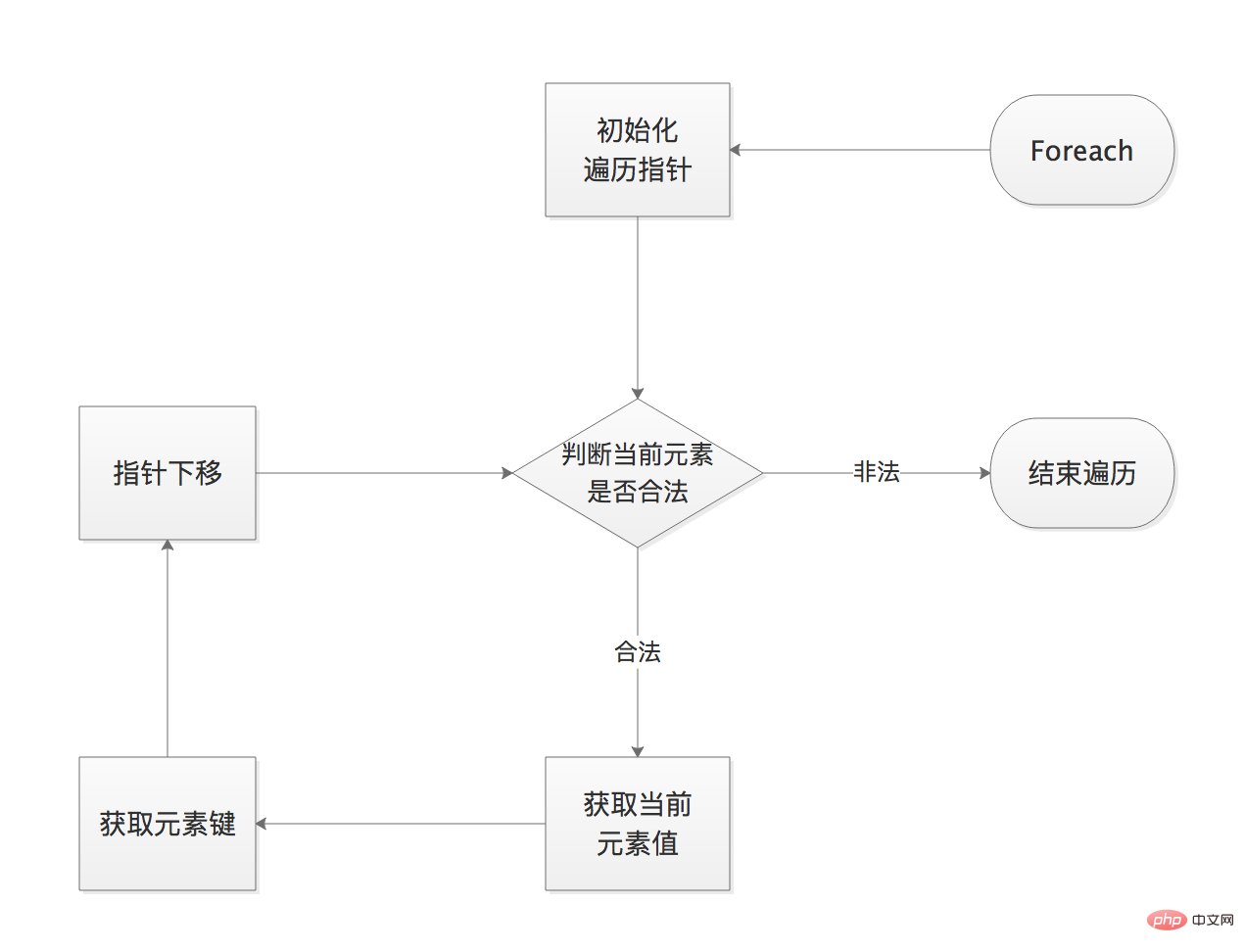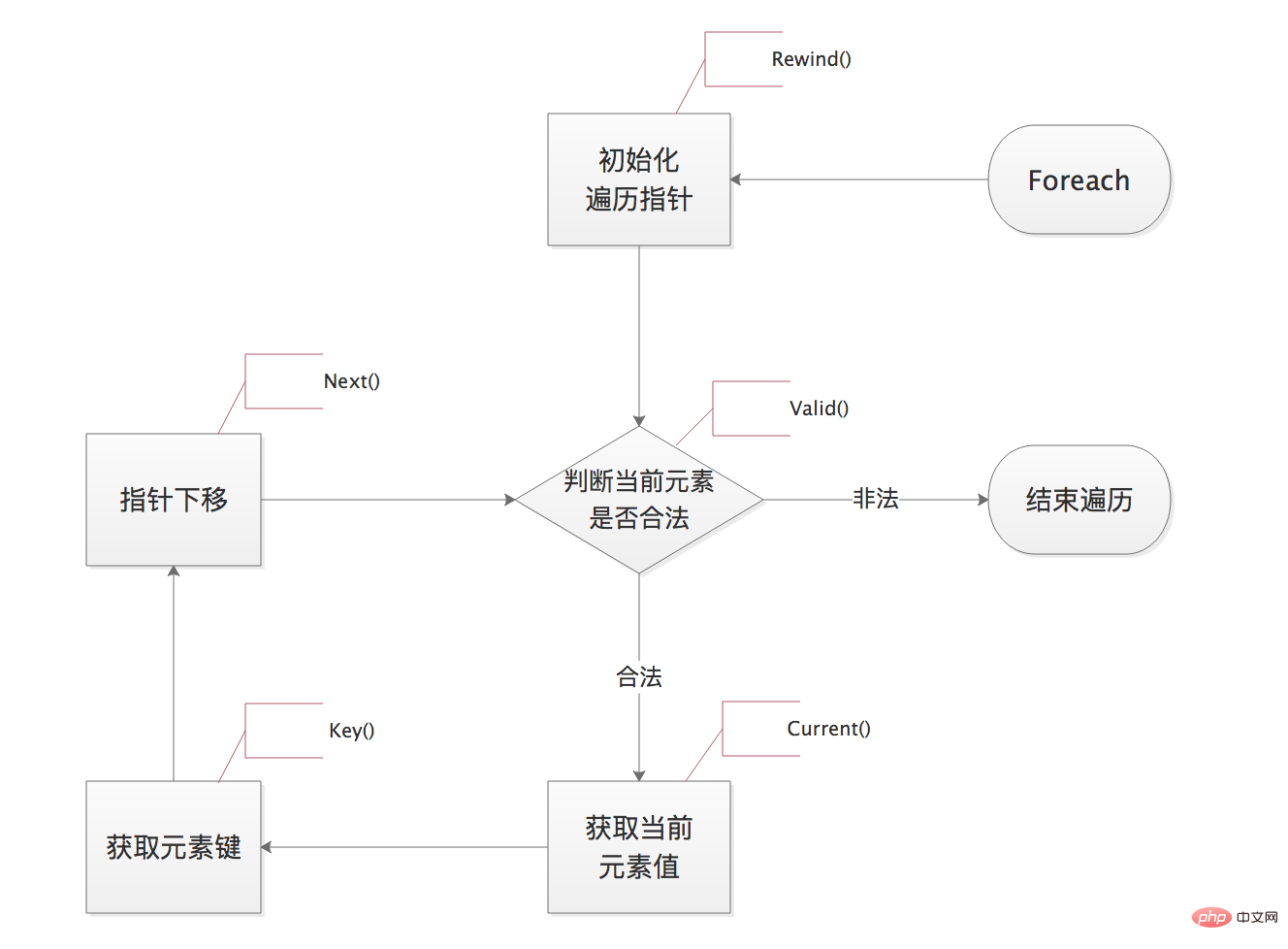Home >Backend Development >PHP Tutorial >PHP object-oriented features
PHP object-oriented features
- little bottleforward
- 2019-04-16 09:53:003457browse
The three main features of object-oriented are encapsulation, inheritance and polymorphism.
Creating objects
$对象名 = new 类名(); $对象名 = new 类名;
- new is a keyword that means creating a new instance.
- Within a class definition, you can create new objects using
new selfandnew parent.
Member attributes
Member attributes must have access modifiers. If not written, an error will be reported.
The default value of member attributes is NULL.
Example:
class Test {
public $name; //共有
protected $height; //保护
private $age; //私有
}Member method
If the member method does not write the access modifier, it defaults to public.
We can specify the type of parameters in the member method, such as class type, or array type (array), or it can be an interface type, but pay attention to the interface type, because the interface has no instance, when we declare the parameter type When it is an interface type, the parameters passed in only need to be instances of the class that implements the interface.
Example:
class Test {
function hello() {} //默认为public
public function say() {} //公有
protected function smile() {} //保护
private function laugh() {} //私有
}Constructor method
- There can only be one constructor method in a class.
- There is no return value (even if the return value is written in the constructor, it is meaningless)
- When creating a new object of a class, the system will automatically call the constructor of the class to complete the new Object initialization.
- If we do not override the default constructor, then the system will help us create a constructor without parameters by default,
public function __construct(){}, if we override the constructor , then our custom constructor will override the system default constructor. - If there are row parameters in our custom constructor, then we must pass in the corresponding actual parameters when we create the object. Otherwise, an error will be reported.
Example:
class Test {
public function __construct() {
echo 'hello, world<br>';
}
}
$testObj = new Test();
class One {
public function __construct($param) {
echo $param;
}
}
$oneObj = new One('hello, world<br>');Output result:
hello, world hello, world
Destruction method
- When an object is not referenced by any variable, It will be destroyed automatically, and the destructor will be automatically called before being destroyed. Regardless of whether the program ends or not, as long as an object is not referenced by any variable, it will be destroyed.
- When the PHP program ends, all objects will be destroyed, and the destructor will be automatically called before the object is destroyed.
- By default, the order in which destructors destroy objects is exactly the opposite of the order in which they are created. The object created first is destroyed last. It is emphasized that by default, we can destroy the object manually. In this case, the order of object destruction is different from the default. When the PHP program is executed, the method of destroying the object at that time is The default method used.
- If we define a class with a special attribute for connecting to the database, when we create an instance object of the class and use the member attribute to connect to the database, if the instance object of this type occupies The resources are large and we often destroy them immediately after use. Although the object can be destroyed, the resources connected to the member properties of the object will not be automatically destroyed and need to be destroyed manually. At this time, we can Just add a statement to close the database connection in the destructor (mysql_close (resource to be closed)).
Example:
class Test {
public function __construct() {
echo 'hello, world<br>';
}
public function __destruct()
{
echo '执行一些回收资源的操作<br>';
}
}
$testObj = new Test();Output result:
hello, world //执行一些回收资源的操作
Garbage collection mechanism
- In PHP, when an object does not have any references When pointing to it, it will become a garbage object, and PHP will enable the garbage collector to destroy the object.
- Before the PHP program exits, PHP will also enable the garbage collector and destroy objects.
Access modifiers
-
public
If no access modifier is specified for a method, it will be
public. Public properties or methods can be accessed inside or outside the class. -
protected
If a property or method specifies the access modifier
protected, then the marked property or method can only be accessed within the class , the modified attributes and methods can be inherited by subclasses. -
private
If a property or method specifies the access modifier
private, then the marked property or method can only be accessed within the class , private properties and methods will not be inherited.
Magic methods
Magic methods are automatically called by the system when certain conditions are met.
The names of magic methods all start with two underscores (__), so when we customize a function, the function name should not start with two underscores.
-
Some commonly used magic methods
__construct(): 构造方法 __destruct(): 析构方法 __set(): 在给不可访问属性赋值(比如:protected/private/不存在)时,__set()会被调用。 __get(): 读取不可访问属性的值(比如:protected/private/不存在)时,__get()会被调用。 __isset(): 当对不可访问属性(比如:protected/private/不存在)调用isset()或empty()时,__isset()会被调用。 __unset(): 当对不可访问属性(比如:protected/private/不存在)调用unset()时,__unset()会被调用。 __toString(): 当我们把一个对象当做字符串输出时,就会自动调用__stoString()方法。 __clone(): 如果定义了__clone方法,则新创建的对象clone(复制生成的对象)中的__clone()会被调用。用法如下: $copy_of_object = clone $object; 克隆后的对象与原对象的地址不一样。 当对象被复制后,PHP 5 会对对象的所有属性执行一个浅复制(shallow copy)。所有的引用属性 仍然会是一个指向原来的变量的引用。 如果想防止其他程序员克隆某个对象,可以重写__clone()方法并把访问修饰符设置为private。 __call(): 在对象中调用一个不可访问(比如函数访问修饰符为protected/private/不存在)方法时,__call()会被调用。 __callStatic(): 用静态方式中调用一个不可访问方法时,__callStatic() 会被调用。
Object comparison
When using comparison operators (==) When comparing two object variables, the comparison principle is: if the attributes and attribute values of the two objects are equal, and the two objects are instances of the same class, then the two object variables are equal.
If you use the equality operator (===), these two object variables must point to the same instance of a certain class (that is, the same object).
Example:
class Test {
public $name = 'itbsl';
public $age = 25;
}
$testObj = new Test();
$testObj2 = new Test();
if ($testObj == $testObj2) {
echo '相等<br>';
} else {
echo '不相等<br>';
}
$testObj2->name = 'jack';
if ($testObj == $testObj2) {
echo '相等<br>';
} else {
echo '不相等<br>';
}继承
即使父类的某些属性设置为私有的,子类仍然能够继承,但是对子类却是不可见的。当子类对象使用父类的私有属性的时候,会自动触发重载机制,在子类创建一个和父类私有属性同名的属性。此时子类使用的属性并不是父类的私有属性了,而是通过重载创建的和父类私有属性同名的属性罢了。
如果在子类中需要访问其父类的构造方法( 方法的访问修饰符是public/protected)可以使用父类::方法名(或者 parent::方法名)来完成。(推荐使用parent::方法名,并且一般调用父类构造方法都是parent::__construct();)
调用父类的普通方法直接用this->方法名即可。(也可以用父类名::方法名或者 parent::方法名 ,但是不推荐)
继承并不是直接把父类的属性和方法直接拷贝到子类里面来。而是建立了一种关联。原本我以为是直接把父类的属性和方法直接拷贝过来,最后发现只是建立了一种关联。下图证明了不是直接拷贝,当在子类里调用父类的方法时,父类输出自己的属性时输出结果都和初始化不一样了(private属性除外,因为是私有的,子类无法看见,所以子类也无法重写父类的私有属性),如果是直接拷贝的话,那么当调用父类的方法时应该输出100,200,300才对,所以说继承不是直接拷贝。
class A {
public $num1 = 100;
protected $num2 = 200;
private $num3 = 300;
public function show1() {
echo 'num1 = ' . $this->num1 . '<br>';
}
public function show2() {
echo 'num2 = ' . $this->num2 . '<br>';
}
public function show3() {
echo 'num3 = ' . $this->num3 . '<br>';
}
}
class B extends A {
public $num1 = 1;
protected $num2 = 2;
private $num3 = 3;
public function show1() {
echo 'num1 = ' . $this->num1 . '<br>';
parent::show1();
}
public function show2() {
echo 'num2 = ' . $this->num2 . '<br>';
parent::show2();
}
public function show3() {
echo 'num3 = ' . $this->num3 . '<br>';
parent::show3();
}
}
$bObj = new B();
$bObj->show1();
$bObj->show2();
$bObj->show3();输出结果:
num1 = 1 num1 = 1 num2 = 2 num2 = 2 num3 = 3 num3 = 300
重载
PHP所提供的"重载"(overloading)是指动态地"创建"类属性和方法。我们是通过魔术方法(magic methods)来实现的。
当调用当前环境下未定义或不可见的类属性或方法时,重载方法会被调用。本节后面将使用"不可访问属性(inaccessible properties)"和"不可访问方法(inaccessible methods)"来称呼这些未定义或不可见的类属性或方法。
属性重载只能在对象中进行。在静态方法中,这些魔术方法将不会被调用。所以这些方法都不能被声明为 static。从 PHP5.3.0 起, 将这些魔术方法定义为 static 会产生一个警告。
所有重载方法都必须被声明为public。
这些魔术方法都参数都不能通过引用传递。
PHP中的"重载"与其它绝大多数面向对象语言不同。传统的"重载"是用于提供多个同名的类方法,但各方法的参数类型和个数不同。
因为PHP处理赋值运算的方式,__set()的返回值将被忽略。类似的,在下面这样的链式赋值中,__get()不会被调用。
$a = $obj->b = 8;
在除 isset() 外的其它语言结构中无法使用重载的属性,这意味着当对一个重载的属性使用 empty() 时,重载魔术方法将不会被调用。
为避开此限制,必须将重载属性赋值到本地变量再使用 empty()。
//在对象中调用一个不可访问方法时,__call() 会被调用。 public mixed __call(string $name , array $arguments) //用静态方式中调用一个不可访问方法时,__callStatic() 会被调用。 public static mixed __callStatic(string $name , array $arguments)
属性重载
我们曾经提过,当我们访问或给一个不可访问(protected/private)的属性或者不存在的属性赋值时,就会调用相应的系统魔术方法__get($property)、__set($property, $value),如果我们不重写这两个方法,当我们给不存在的属性赋值时,系统会自动帮我们创建一个public的属性,我们可以自己重写这两个方法来管理这些这些动态创建的属性。或者直接不让产生动态属性。当我们不重写这两个方法就不可访问属性赋值时,会报致命错误。
示例:
class Obj {
protected $name = 'itbsl';
}
$obj = new Obj();
$obj->name = "jack"; //此处会报致命错误
var_dump($obj);错误信息为:
Fatal error: Uncaught Error: Cannot access protected property Obj::$name
当我们重写了__set()方法就没问题了
class Obj {
protected $str = 'itbsl';
public function __set($name, $value)
{
$this->$name = $value;
}
}
$obj = new Obj();
$obj->str = "jack";
var_dump($obj);属性重载可以帮助我们动态管理新的属性也可以禁止动态创建属性。
(1)动态管理
class Dog {
//定义一个数组,管理我们动态增加的属性和值
private $arr = [];
//这里我们重写__set来管理动态增加的属性
public function __set($name, $value)
{
$this->arr[$name] = $value;
}
public function __get($name)
{
return isset($this->arr[$name]) ? $this->arr[$name] : null;
}
}(2)禁止创建动态属性。重写set方法,里面什么也不做。
class Dog {
//这里我们重写__set来管理动态增加的属性
public function __set($name, $value)
{
//just do nothing
}
}方法重写
在子类中重写父类的方法时要,重写的方法的访问控制符不能比父类的方法的访问控制符的级别小。例如:如果父类的访问控制符为public,则子类重写方法的访问修饰符只能为public,如果父类的为protected,则子类的访问修饰控制符可以为protected或public。重写属性也要遵守上面的规则。
属性重写
如果子类有和父类相同的属性,如果属性是public或者protected则会重写父类的属性,如果是private则创建一个同名的新私有属性,同时仍然会继承父类的同名私有属性。
静态属性
- 静态属性不属于某个对象,而是所有对象共享的属性,每个对象都可以访问它。
- 静态属性属于类的范畴,而不是某个对象的独有特性。
- 在类中,使用和访问静态变量的方式是
self::$静态属性。 - 在类外,使用和访问静态变量的方式是
类名::$静态属性(要求访问修饰符为public)。 - 当我们用var_dump()输出一个对象的时候,该对象的静态变量不会被输出。
- 就像其它所有的 PHP 静态变量一样,静态属性只能被初始化为文字或常量,不能使用表达式。所以可以把静态属性初始化为整数或数组,但不能初始化为另一个变量或函数返回值,也不能指向一个对象。
静态方法
- 静态方法的访问方式为
类名::静态方法名(); 同时也可以用对象名->静态方法名();和对象名::静态方法名(),但是后两种不推荐,尽量只用第一种。 - 在类的外部调用静态方法,要求静态方法的访问修饰符必须是public的。
- 在类内部调用静态方法:
self::静态方法或者类名::静态方法通过$this也可以。只推荐第一种方式。在类的内部访问静态方法,无论是什么修饰符都可以访问静态方法。 - 静态方法中不可以访问非静态属性和非静态方法。
- 普通的成员方法,可以访问静态属性。
静态属性和普通属性的区别:
(1)加上static称静态变量,否则就是普通属性
(2)静态属性是与类相关的,所有对象共享的属性
(3)普通属性属于每个对象个体的属性。
多态
由于PHP变量没有类型限制,所以PHP是天生支持多态的。
类型约束
类型约束支持的类型有 array 、 callable 、 对象类型 、 接口
抽象类
当父类的一些方法不能确定时,可以用abstract关键字来修饰该方法[抽象方法],用abstract来修饰该类[抽象类]。
(1) 如果你希望把某个方法做成 抽象方法 ,则前面写上 abstract
(2) 如果一个类中有抽象方法,那么该类必须声明为抽象类。
(3) 抽象类最主要的作用在于设计,它的目的是让其它的类继承它,并实现其中的抽象方法。如果子类继承了该抽象类,除非继承该抽象类的子类也被声明为抽象类,否则必须实现抽象类中所有的抽象方法,如果不实现就会报错。
(4) 抽象类不能被实例化
(5) 抽象类可以没有abstract方法
(6) 抽象类可以有非抽象方法,成员属性和常量
(7) 抽象方法不能有函数体
基本语法:
abstract class 类名 {
abstract 修饰符 function 函数名(参数列表);
}普通类如何继承抽象类?
abstract class Superman {
public $name;
public $age;
public function __construct($name, $age) {
$this->name = $name;
$this->age = $age;
}
abstract public function run();
abstract public function fly();
abstract public function attach();
}
class Spiderman extends Superman {
public function run()
{
echo 'Spiderman is running on the net.<br>';
}
public function fly()
{
echo 'Spiderman can hang in the sky through net.<br>';
}
public function attach()
{
echo 'Spider attach.<br>';
}
}接口
(1) 接口就是给出一些没有实现的方法,封装到一起,到某个类要使用的时候,再根据具体情况把这些方法写出来。
(2)基本语法:
interface 接口名 {
//方法[不含方法体]
}(3)接口中所有的方法都不能有主体
(4)一个类可以实现多个接口,接口名之间用逗号隔开
class 类名 implements 接口1, 接口2 {
}(5)接口中可以有属性,但只能是常量,并且是公开可访问的。默认是public,但不能用public显式修饰
(6)接口中的方法都必须是public的,默认就是public
(7)一个接口不能继承其它的类,但是可以继承别的接口,而且一个接口可以继承多个接口
interface 接口名 extends 接口1, 接口2 {
//方法[不含方法体]
}(8)接口不能被实例化
(9)接口是更加抽象的抽象类,接口里的所有方法都没有方法体。接口体现了程序设计的多态和高内聚低耦合的设计思想。
(10)说明:
接口的命名规范一般是字符 i 开头,然后第二个字符大写,形式如:iXxxx,比如:iUsb
(11)如何使用接口中的常量
接口名::常量名;
如果某个类要实现接口,需要用implements 关键字。并且实现接口里的所有方法,如果该类要实现多个接口,则所有的接口的所有的方法都要实现,只要存在没有实现的接口里的方法就会报错。
示例:
interface Displayable {
function display();
}
class Base {
function operation() {
echo 'operate something.<br>';
}
}
class SubClass extends Base implements Displayable {
function display()
{
echo 'display.<br>';
}
}
$temp = new SubClass();
$temp->display();final关键字
(1) 作用:
因为安全的考虑,类的某个方法不允许子类通过重写来修改。
不希望某个类被其它的类继承。
(2) PHP5新增了一个final关键字。如果父类中的方法被声明为final,则子类无法覆盖该方法。如果一个类被声明为final,则该类不能被继承。
(3) final不能够修饰成员属性(变量)
(4) final方法不能被重写,但可以被继承。即使是被声明为final的方法也依然能够被继承并被使用,只是不能重写(修改)罢了。
(5) 一般来说,final类中不会出现final方法,因为final类都不能被继承,也就不会去重写override final类的方法了。
(6) final类是可以被实例化的。
类常量
可以把在类中始终保持不变的值定义为常量。在定义和使用常量的时候不需要使用 $ 符号。
常量的值必须是一个定值,不能是变量、类属性、数学运算的结果或函数调用。
接口(interface)中也可以定义常量。更多示例见文档中的接口部分。
自 PHP 5.3.0 起,可以用一个变量来动态调用类。但该变量的值不能为关键字(如 self,parent 或 static)。
细节说明:
(1) 常量名一般字母全部大写:TAX_RATE,中间可以有下划线
(2) 在定义常量的同时,必须赋初值,比如 const TAX_RATE = 1.1
(3) const关键字前不能用public/protected/private修饰。默认是public
(4) 访问常量
在类的外部 类名::常量名 接口名::常量名
在类的内部 类名::常量名 self::常量名
(5) 常量的值在定义的时候就初始化,以后就不能修改
(6) 常量可以被子类继承
(7) 一个常量是属于一个类的,而不是某个对象的。
(8) 常量是全局性的,可以在任何地方访问。
(9) 在类里面不能用define定义常量。
(10) 常量的值可以是基本类型数据和数组。不可以是对象。
对象遍历
foreach用法和之前的数组遍历是一样的,只不过这里遍历的key是属性名,value是属性值。在类外部遍历时,只能遍历到public属性的,因为其它的都是受保护的,类外部不可见。
示例:
class HardDiskDrive {
public $brand;
public $color;
public $cpu;
public $workState;
protected $memory;
protected $hardDisk;
private $price;
public function __construct($brand, $color, $cpu, $workState, $memory, $hardDisk, $price) {
$this->brand = $brand;
$this->color = $color;
$this->cpu = $cpu;
$this->workState = $workState;
$this->memory = $memory;
$this->hardDisk = $hardDisk;
$this->price = $price;
}
}
$hardDiskDrive = new HardDiskDrive('希捷', 'silver', 'tencent', 'well', '1T', 'hard', '$456');
foreach ($hardDiskDrive as $property => $value) {
var_dump($property, $value);
echo '<br>';
}输出结果为:
string(5) "brand" string(6) "希捷" string(5) "color" string(6) "silver" string(3) "cpu" string(7) "tencent" string(9) "workState" string(4) "well"
如果我们想遍历出对象的所有属性,就需要控制foreach的行为,就需要给类对象,提供更多的功能,需要继承自Iterator的接口:
该接口,实现了foreach需要的每个操作。foreach的执行流程如下图:

看图例中,foreach中有几个关键步骤:5个。
而Iterator迭代器中所要求的实现的5个方法,就是用来帮助foreach,实现在遍历对象时的5个关键步骤:
当foreach去遍历对象时, 如果发现对象实现了Ierator接口, 则执行以上5个步骤时, 不是foreach的默认行为, 而是调用对象的对应方法即可:

示例代码:
class Team implements Iterator {
//private $name = 'itbsl';
//private $age = 25;
//private $hobby = 'fishing';
private $info = ['itbsl', 25, 'fishing'];
public function rewind()
{
reset($this->info); //重置数组指针
}
public function valid()
{
//如果为null,表示没有元素,返回false
//如果不为null,返回true
return !is_null(key($this->info));
}
public function current()
{
return current($this->info);
}
public function key()
{
return key($this->info);
}
public function next()
{
return next($this->info);
}
}
$team = new Team();
foreach ($team as $property => $value) {
var_dump($property, $value);
echo '<br>';
}PHP内置标准类
如果我们希望把一些数据,以对象的属性的方式存储,同时我们又不想定义一个类,可以考虑使用PHP内置标准类stdClass[standard标准]
基本用法:
//注意: stdClass()不是我们自定义的类,而是PHP内置的 $person = new stdClass();
然后我们就可以直接用$person->属性的方式来使用,属性都不是系统的,我们自己也没定义,但是当我们使用这个属性的时候,系统发现没有定义就会调用重载方法,重载这个属性。自动帮我们创建这个属性。
其它数据类型转成对象
如果,我们希望把非对象类型转换成对象,可以通过如下方法实现,(object)来强制转换,把这些数据转换成标准内置类stdClass,此种转换不改变原有数据类型
【推荐课程:PHP视频教程】
The above is the detailed content of PHP object-oriented features. For more information, please follow other related articles on the PHP Chinese website!

